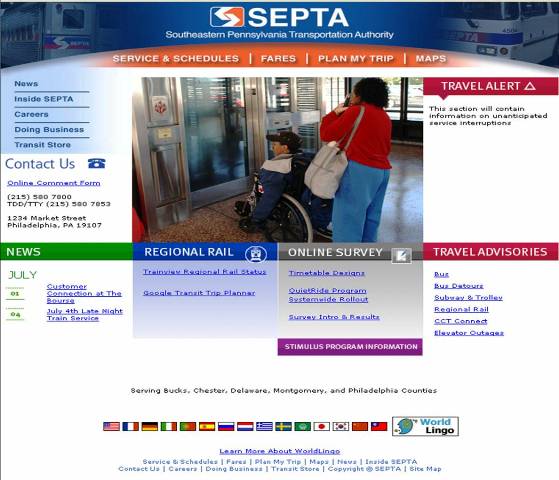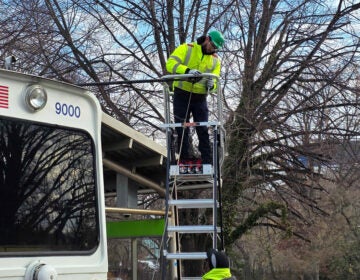SEPTA embraces new technology

SEPTA’s new website
June 30
By Anthony Campisi
For PlanPhilly
On Tuesday, SEPTA officially joined the more than 400 transit agencies around the world that allow riders to plan their trips using Google Transit.
The service connects the schedules of SEPTA trains, subways and light rail and trolley routes with Google Maps, allowing passengers to type in their starting location, desired end point and the date and time of their trip. The system then provides them with directions on which routes to take.
SEPTA says that bus routes will be available on Google Transit by the end of the year. The agency is in the process of “geo-locating” all its bus stops so it can provide Google with the exact latitude and longitude of each, which is necessary to integrate bus routes into the system.
Google Transit also shows transfer points to other transit agencies. For instance, a rider wanting to take the train to New York Penn Station from 30th Street Station will be directed to take the R7 to Trenton and then transfer to New Jersey Transit’s Northeast Corridor Line.
Riders will also be able to input tourist attractions into Google Transit. For example, a tourist can find directions from the airport to the Convention Center simply by typing both places into the Google Transit prompts.
People who use Google Maps to find places like restaurants will be automatically presented with the option of using SEPTA for their transportation anywhere in the five-county service area. And because the system operates out of Google Maps, riders don’t need to know the specific address of the place they’re looking for in order to find it.
Google Transit was first released in 2007. It took SEPTA until now to recode its service data into a form readable by Google and to geo-locate its system for the company. In an online survey taken in September and October of last year, adding Google Transit tied for first as the function riders most wanted to see SEPTA adopt.
SEPTA has made the scheduling information it prepared for Google available to the public at septa.org/developer, SEPTA spokesman Brian Anderson said at a press conference unveiling the program. Programmers will be able to use that information to develop their own applications using the transit information.
Ron Hopkins, SEPTA’s chief control center officer, said that he envisions that less frequent riders, like tourists, will be the primary users of Google Transit because the system is currently unable to provide real-time information on delays.
To provide that, SEPTA previewed a system in which commuters will be able to enter their starting and ending regional rail stations and get real-time scheduling information. The service will take into account delays and function alongside the SEPTA Train View http://trainview.septa.org
Hopkins said that the Train View system can be difficult for riders to use because they need to know the number of the train they plan to catch. The new system will just require regional rail riders to know their starting and ending stations.
SEPTA plans to release that system in the next few weeks. It will also be available to PDA users and is geared toward commuters.
SEPTA’s own trip planning function will still be available and contains “more detailed route information,” Anderson said.
The agency also announced that it’s trying its hand at social networking. By the end of the week, SEPTA will be posting unanticipated service disruptions on its Twitter account www.twitter.com/septa as a way of disseminating the information to commuters as quickly as possible. Riders will be able to check it and the SEPTA homepage www.septa.org for real-time information on major delays.
Jasmine Nicholes of West Philadelphia didn’t find much that would help commuters like herself.
While tourists might find Google Transit useful, she said that she knows the system and doesn’t need directions to get places. And the fact that many SEPTA riders do not have access to the Internet will keep them from checking sites like Twitter for system updates. She would rather the agency focus on improving service.
But Jennifer Romansi of South Philadelphia said that she appreciates the ability Google Transit gives riders to “see [their trips] visually.” Though as a long-time resident she rarely needs directions to get around, she would consider using the new service when going “somewhere new.”
And Juliette S. Hooke, said that the agency for trying to get transit information to riders in new ways.
“They need to” improve communication with the public, she said, adding that she would use Google Transit to plan her trips.
Contact the reporter at campisi.anthony@gmail.com
WHYY is your source for fact-based, in-depth journalism and information. As a nonprofit organization, we rely on financial support from readers like you. Please give today.






